Copper Stress Levels Classification in Oilseed Rape Using Deep Residual Networks and Hyperspectral False-Color Images
Abstract
1. Introduction
2. Materials and Methods
2.1. Experimental Design
2.2. Hyperspectral Image Acquisition
2.3. Hyperspectral Data Preprocessing
2.3.1. Spatial Domain Preprocessing
2.3.2. Spectral Domain Preprocessing
2.4. Classification Model
2.4.1. SVM
2.4.2. Basic 1D-CNN
2.4.3. Residual Network
2.5. PCA-Based False-Color Image Construction
2.6. Dataset Construction
2.6.1. 1D Spectral Sequences
2.6.2. Visible-Light Images
2.6.3. False-Color Images
2.7. Evaluation Metrics
2.8. Experimental Setup
2.8.1. Software Platforms
2.8.2. Environment and Hardware
2.8.3. Hyperparameter Settings
3. Experiment and Results
3.1. Chemical and Spectral Analysis
3.2. 1D Spectral Classification
3.2.1. Spectral Preprocessing
3.2.2. SVM vs. B1DCNN
3.2.3. 1D Residual Network
3.3. Image Classification
3.3.1. Preliminary Experiments
3.3.2. Model Evaluation
3.4. Feature Visualization
4. Discussion
5. Conclusions
Author Contributions
Funding
Data Availability Statement
Conflicts of Interest
Abbreviations
| HSI | Hyperspectral imaging |
| CNN | Convolutional neural network |
| 1D | One-dimensional |
| 1D-CNN | One-dimensional convolutional neural network |
| PCA | Principal component analysis |
| SVM | Support vector machine |
| CK | Control group |
| ROI | Region of interest |
| SG | Savitzky–Golay smoothing |
| GD | Gap derivative |
| MSC | Multiplicative scatter correction |
| B1DCNN | Basic 1D-CNN model |
| PC | Principal component |
| Iijk | False-color image constructed based on specific PC mapping strategies |
| Dv | Visible-light image dataset |
| Df | False-color image dataset |
| Dijk | Dataset constructed from false-color images Iijk |
| SG-GD-MSC | Combined preprocessing strategy using SG, GD, and MSC |
References
- Jiang, H.; Wang, Z.; Deng, J.; Ding, Z.; Chen, Q. Quantitative detection of heavy metal Cd in vegetable oils: A nondestructive method based on Raman spectroscopy combined with chemometrics. J. Food Sci. 2024, 89, 8054–8065. [Google Scholar] [CrossRef]
- Guo, Z.; Chen, P.; Yosri, N.; Chen, Q.; Elseedi, H.R.; Zou, X.; Yang, H. Detection of heavy metals in food and agricultural products by surface-enhanced Raman spectroscopy. Food Rev. Int. 2023, 39, 1440–1461. [Google Scholar] [CrossRef]
- Hossain, M.M.; Tripty, S.J.; Shishir, M.Z.A.; Wang, S.; Hossain, I.; Geng, A.; Han, S.; Zhu, D. Malondialdehyde and heavy metal contents in Piper betel: Possible risks of heavy metals in human health. J. Food Compos. Anal. 2024, 134, 106540. [Google Scholar] [CrossRef]
- Zhang, W.; Liu, C.; Liu, F.; Zou, X.; Xu, Y.; Xu, X. A smart-phone-based electrochemical platform with programmable solid-state-microwave flow digestion for determination of heavy metals in liquid food. Food Chem. 2020, 303, 125378. [Google Scholar] [CrossRef] [PubMed]
- Azam, K.; Akhtar, S.; Gong, Y.Y.; Routledge, M.N.; Ismail, A.; Oliveira, C.A.; Iqbal, S.Z.; Ali, H. Evaluation of the impact of activated carbon-based filtration system on the concentration of aflatoxins and selected heavy metals in roasted coffee. Food Control 2021, 121, 107583. [Google Scholar] [CrossRef]
- Zaman, F.; Zhang, E.; Ihtisham, M.; Ilyas, M.; Khattak, W.A.; Guo, F.; Wang, P.; Wang, M.; Wang, Y.; Ni, D. Metabolic profiling, pigment component responses to foliar application of Fe, Zn, Cu, and Mn for tea plants (Camellia sinensis). Sci. Hortic. 2023, 319, 112149. [Google Scholar] [CrossRef]
- Cao, X.; Wang, X.; Tong, W.; Gurajala, H.K.; Lu, M.; Hamid, Y.; Feng, Y.; He, Z.; Yang, X. Distribution, availability and translocation of heavy metals in soil-oilseed rape (Brassica napus L.) system related to soil properties. Environ. Pollut. 2019, 252, 733–741. [Google Scholar] [CrossRef]
- Yruela, I. Copper in plants. Braz. J. Plant Physiol. 2005, 17, 145–156. [Google Scholar] [CrossRef]
- Van Assche, F.; Clijsters, H. Effects of metals on enzyme activity in plants. Plant Cell Environ. 1990, 13, 195–206. [Google Scholar] [CrossRef]
- Wang, C.; Wu, B.; Jiang, K.; Wei, M.; Wang, S. Effects of different concentrations and types of Cu and Pb on soil N-fixing bacterial communities in the wheat rhizosphere. Appl. Soil Ecol. 2019, 144, 51–59. [Google Scholar] [CrossRef]
- Lu, Y.; Wang, Y.; Wu, B.; Wang, S.; Wei, M.; Du, D.; Wang, C. Allelopathy of three Compositae invasive alien species on indigenous Lactuca sativa L. enhanced under Cu and Pb pollution. Sci. Hortic. 2020, 267, 109323. [Google Scholar] [CrossRef]
- Zhou, C.; Pan, W.; Peng, Q.; Chen, Y.; Zhou, T.; Wu, C.; Hartley, W.; Li, J.; Xu, M.; Liu, C. Characteristics of metabolites by seed-specific inhibition of FAD2 in Brassica napus L. J. Agric. Food. Chem. 2021, 69, 5452–5462. [Google Scholar] [CrossRef]
- Wang, A.; Gao, B.; Cao, H.; Wang, P.; Zhang, T.; Wei, X. Early detection of Sclerotinia sclerotiorum on oilseed rape leaves based on optical properties. Biosyst. Eng. 2022, 224, 80–91. [Google Scholar] [CrossRef]
- Migocka, M.; Malas, K. Plant responses to copper: Molecular and regulatory mechanisms of copper uptake, distribution and accumulation in plants. In Plant Micronutrient Use Efficiency; Elsevier: Amsterdam, The Netherlands, 2018; pp. 71–86. [Google Scholar]
- Xu, Y.; Kutsanedzie, F.Y.; Ali, S.; Wang, P.; Li, C.; Ouyang, Q.; Li, H.; Chen, Q. Cysteamine-mediated upconversion sensor for lead ion detection in food. J. Food Meas. Charact. 2021, 15, 4849–4857. [Google Scholar] [CrossRef]
- Guo, Z.; Chen, P.; Yin, L.; Zuo, M.; Chen, Q.; El-Seedi, H.R.; Zou, X. Determination of lead in food by surface-enhanced Raman spectroscopy with aptamer regulating gold nanoparticles reduction. Food Control 2022, 132, 108498. [Google Scholar] [CrossRef]
- Zhou, X.; Zhao, C.; Sun, J.; Cao, Y.; Yao, K.; Xu, M. A deep learning method for predicting lead content in oilseed rape leaves using fluorescence hyperspectral imaging. Food Chem. 2023, 409, 135251. [Google Scholar] [CrossRef]
- Wang, X.; Xu, Y.; Li, Y.; Li, Y.; Li, Z.; Zhang, W.; Zou, X.; Shi, J.; Huang, X.; Liu, C. Rapid detection of cadmium ions in meat by a multi-walled carbon nanotubes enhanced metal-organic framework modified electrochemical sensor. Food Chem. 2021, 357, 129762. [Google Scholar] [CrossRef] [PubMed]
- Zhang, W.; Xu, Y.; Zou, X. Rapid determination of cadmium in rice using an all-solid RGO-enhanced light addressable potentiometric sensor. Food Chem. 2018, 261, 1–7. [Google Scholar] [CrossRef] [PubMed]
- Liu, J.; Kang, L.; Du, L.; Liao, S.; Dong, W.; Ma, M.; Zou, G.; Li, S. Distribution, accumulation and translocation of the heavy metal Cd in various varieties of edible rapeseed under Cd stress. Sustainability 2024, 16, 2876. [Google Scholar] [CrossRef]
- Li, L.; Fan, Z.; Gan, Q.; Xiao, G.; Luan, M.; Zhu, R.; Zhang, Z. Conservative mechanism through various rapeseed (Brassica napus L.) varieties respond to heavy metal (Cadmium, Lead, Arsenic) stress. Front. Plant Sci. 2025, 15, 1521075. [Google Scholar] [CrossRef]
- Khulal, U.; Zhao, J.; Hu, W.; Chen, Q. Nondestructive quantifying total volatile basic nitrogen (TVB-N) content in chicken using hyperspectral imaging (HSI) technique combined with different data dimension reduction algorithms. Food Chem. 2016, 197, 1191–1199. [Google Scholar] [CrossRef]
- Bonah, E.; Huang, X.; Aheto, J.H.; Osae, R. Application of hyperspectral imaging as a nondestructive technique for foodborne pathogen detection and characterization. Foodborne Pathog. Dis. 2019, 16, 712–722. [Google Scholar] [CrossRef]
- Zhang, D.; Chen, X.; Lin, Z.; Lu, M.; Yang, W.; Sun, X.; Battino, M.; Shi, J.; Huang, X.; Shi, B. Nondestructive detection of pungent and numbing compounds in spicy hotpot seasoning with hyperspectral imaging and machine learning. Food Chem. 2025, 469, 142593. [Google Scholar] [CrossRef] [PubMed]
- Zhou, X.; Liu, Y.; Sun, J.; Li, B.; Xiao, G. Nondestructive detection of lead content in oilseed rape leaves under silicon action using hyperspectral image. Sci. Total Environ. 2024, 949, 175076. [Google Scholar] [CrossRef] [PubMed]
- Wambugu, N.; Chen, Y.; Xiao, Z.; Tan, K.; Wei, M.; Liu, X.; Li, J. Hyperspectral image classification on insufficient-sample and feature learning using deep neural networks: A review. Int. J. Appl. Earth Obs. Geoinf. 2021, 105, 102603. [Google Scholar] [CrossRef]
- Paoletti, M.E.; Haut, J.M.; Plaza, J.; Plaza, A. Deep learning classifiers for hyperspectral imaging: A review. ISPRS J. Photogramm. Remote Sens. 2019, 158, 279–317. [Google Scholar] [CrossRef]
- Su, H.; Du, Q.; Du, P. Hyperspectral image visualization using band selection. IEEE J. Sel. Top. Appl. Earth Obs. Remote Sens. 2013, 7, 2647–2658. [Google Scholar] [CrossRef]
- Li, C.; Zhang, B.; Hong, D.; Zhou, J.; Vivone, G.; Li, S.; Chanussot, J. CasFormer: Cascaded transformers for fusion-aware computational hyperspectral imaging. Inf. Fusion 2024, 108, 102408. [Google Scholar] [CrossRef]
- Shi, W.; Koo, D.E.; Kitano, M.; Chiang, H.J.; Trinh, L.A.; Turcatel, G.; Steventon, B.; Arnesano, C.; Warburton, D.; Fraser, S.E. Pre-processing visualization of hyperspectral fluorescent data with Spectrally Encoded Enhanced Representations. Nat. Commun. 2020, 11, 726. [Google Scholar] [CrossRef]
- Cortes, C.; Vapnik, V. Support-vector networks. Mach. Learn. 1995, 20, 273–297. [Google Scholar] [CrossRef]
- Jankovska-Bortkevič, E.; Gavelienė, V.; Koryznienė, D.; Jankauskienė, J.; Mockevičiūtė, R.; Jurkonienė, S. Response of winter oilseed rape to imitated temperature fluctuations in autumn-winter period. Environ. Exp. Bot. 2019, 166, 103801. [Google Scholar] [CrossRef]
- Aryani, R.D.; Nugroho, A.P.; Purwestri, Y.A. Effects of Copper on Accumulation, Plant Growth, Superoxide Dismutase Activity and Total Phenolic Compounds in Paddy (Oryza sativa L. ‘Cempo Merah’) Leaves. In Proceedings of the 2nd International Conference on Tropical Agriculture, Eastparc Hotel, Yogyakarta, Indonesia, 26–27 October 2017; Springer: Berlin/Heidelberg, Germany, 2018; pp. 195–203. [Google Scholar]
- Gong, Q.; Wang, L.; Dai, T.; Zhou, J.; Kang, Q.; Chen, H.; Li, K.; Li, Z. Effects of copper on the growth, antioxidant enzymes and photosynthesis of spinach seedlings. Ecotoxicol. Environ. Saf. 2019, 171, 771–780. [Google Scholar] [CrossRef]
- Wu, J.; Fu, X.; Yu, C.; Lv, S.; Lv, J.; Zhao, L.; Du, S.; Li, S.; Ma, F.; Guo, H. Combined physiological, metabolomic and response surface approaches to analyze copper stress resistance mechanisms and repair potential of Epipremnum aureum. Sci. Hortic. 2024, 338, 113642. [Google Scholar] [CrossRef]
- Savitzky, A.; Golay, M.J. Smoothing and differentiation of data by simplified least squares procedures. Anal. Chem. 1964, 36, 1627–1639. [Google Scholar] [CrossRef]
- Putri, I. The application of NIRS method for non-destructive measurement of fat and carbohydrates in pumpkin seeds. In IOP Conference Series: Earth and Environmental Science; IOP Publishing: Bristol, UK, 2021; Volume 922, p. 012024. [Google Scholar]
- Geladi, P.; MacDougall, D.; Martens, H. Linearization and scatter-correction for near-infrared reflectance spectra of meat. Appl. Spectrosc. 1985, 39, 491–500. [Google Scholar] [CrossRef]
- Ding, Y.; Yan, Y.; Li, J.; Chen, X.; Jiang, H. Classification of tea quality levels using near-infrared spectroscopy based on CLPSO-SVM. Foods 2022, 11, 1658. [Google Scholar] [CrossRef]
- Huang, H.; Huang, S.; Du, Q. Evaluation of soil heavy metal pollution based on K-means and SVM. Int. J. Environ. Sci. Technol. 2023, 20, 12015–12024. [Google Scholar] [CrossRef]
- Hong, S.; Xu, Y.; Khare, A.; Priambada, S.; Maher, K.; Aljiffry, A.; Sun, J.; Tumanov, A. Holmes: Health online model ensemble serving for deep learning models in intensive care units. In Proceedings of the 26th ACM SIGKDD International Conference on Knowledge Discovery & Data Mining, Virtual Event, 6–10 July 2020; ACM: San Francisco, CA, USA, 2020; pp. 1614–1624. [Google Scholar]
- Krizhevsky, A.; Sutskever, I.; Hinton, G.E. ImageNet classification with deep convolutional neural networks. Commun. ACM 2017, 60, 84–90. [Google Scholar] [CrossRef]
- He, K.; Zhang, X.; Ren, S.; Sun, J. Deep residual learning for image recognition. In Proceedings of the IEEE conference on computer vision and pattern recognition, Las Vegas, NV, USA, 27–30 June 2016; pp. 770–778. [Google Scholar]
- Xie, S.; Girshick, R.; Dollár, P.; Tu, Z.; He, K. Aggregated residual transformations for deep neural networks. In Proceedings of the IEEE conference on computer vision and pattern recognition, Honolulu, HI, USA, 21–26 July 2017; pp. 1492–1500. [Google Scholar]
- Radosavovic, I.; Kosaraju, R.P.; Girshick, R.; He, K.; Dollár, P. Designing network design spaces. In Proceedings of the IEEE/CVF conference on computer vision and pattern recognition, Seattle, WA, USA, 13–19 June 2020; pp. 10428–10436. [Google Scholar]
- Jolliffe, I. A 50-year personal journey through time with principal component analysis. J. Multivar. Anal. 2022, 188, 104820. [Google Scholar] [CrossRef]
- Kingma, D.P. Adam: A method for stochastic optimization. arXiv 2014, arXiv:1412.6980. [Google Scholar] [CrossRef]
- Cao, Y.; Sun, J.; Yao, K.; Xu, M.; Tang, N.; Zhou, X. Nondestructive detection of lead content in oilseed rape leaves based on MRF-HHO-SVR and hyperspectral technology. J. Food Process Eng. 2021, 44, e13793. [Google Scholar] [CrossRef]
- Fu, L.; Sun, J.; Wang, S.; Xu, M.; Yao, K.; Zhou, X. Nondestructive evaluation of Zn content in rape leaves using MSSAE and hyperspectral imaging. Spectrochim. Acta Part A Mol. Biomol. Spectrosc. 2022, 281, 121641. [Google Scholar] [CrossRef] [PubMed]
- Selvaraju, R.R.; Cogswell, M.; Das, A.; Vedantam, R.; Parikh, D.; Batra, D. Grad-CAM: Visual explanations from deep networks via gradient-based localization. Int. J. Comput. Vis. 2020, 128, 336–359. [Google Scholar] [CrossRef]
- Li, J.; Luo, W.; Han, L.; Cai, Z.; Guo, Z. Two-wavelength image detection of early decayed oranges by coupling spectral classification with image processing. J. Food Compos. Anal. 2022, 111, 104642. [Google Scholar] [CrossRef]
- Qiu, G.; Lu, H.; Wang, X.; Wang, C.; Xu, S.; Liang, X.; Fan, C. Nondestructive detecting maturity of pineapples based on visible and near-infrared transmittance spectroscopy coupled with machine learning methodologies. Horticulturae 2023, 9, 889. [Google Scholar] [CrossRef]
- Jun, S.; Xin, Z.; Xiaohong, W.; Bing, L.; Chunxia, D.; Jifeng, S. Research and analysis of cadmium residue in tomato leaves based on WT-LSSVR and Vis-NIR hyperspectral imaging. Spectrochim. Acta Part A 2019, 212, 215–221. [Google Scholar] [CrossRef]
- Zhou, X.; Sun, J.; Zhang, Y.; Tian, Y.; Yao, K.; Xu, M. Visualization of heavy metal cadmium in lettuce leaves based on wavelet support vector machine regression model and visible-near infrared hyperspectral imaging. J. Food Process Eng. 2021, 44, e13897. [Google Scholar] [CrossRef]
- Ding, Y.; Zeng, R.; Jiang, H.; Guan, X.; Jiang, Q.; Song, Z. Classification of tea quality grades based on hyperspectral imaging spatial information and optimization models. J. Food Meas. Charact. 2024, 18, 9098–9112. [Google Scholar] [CrossRef]

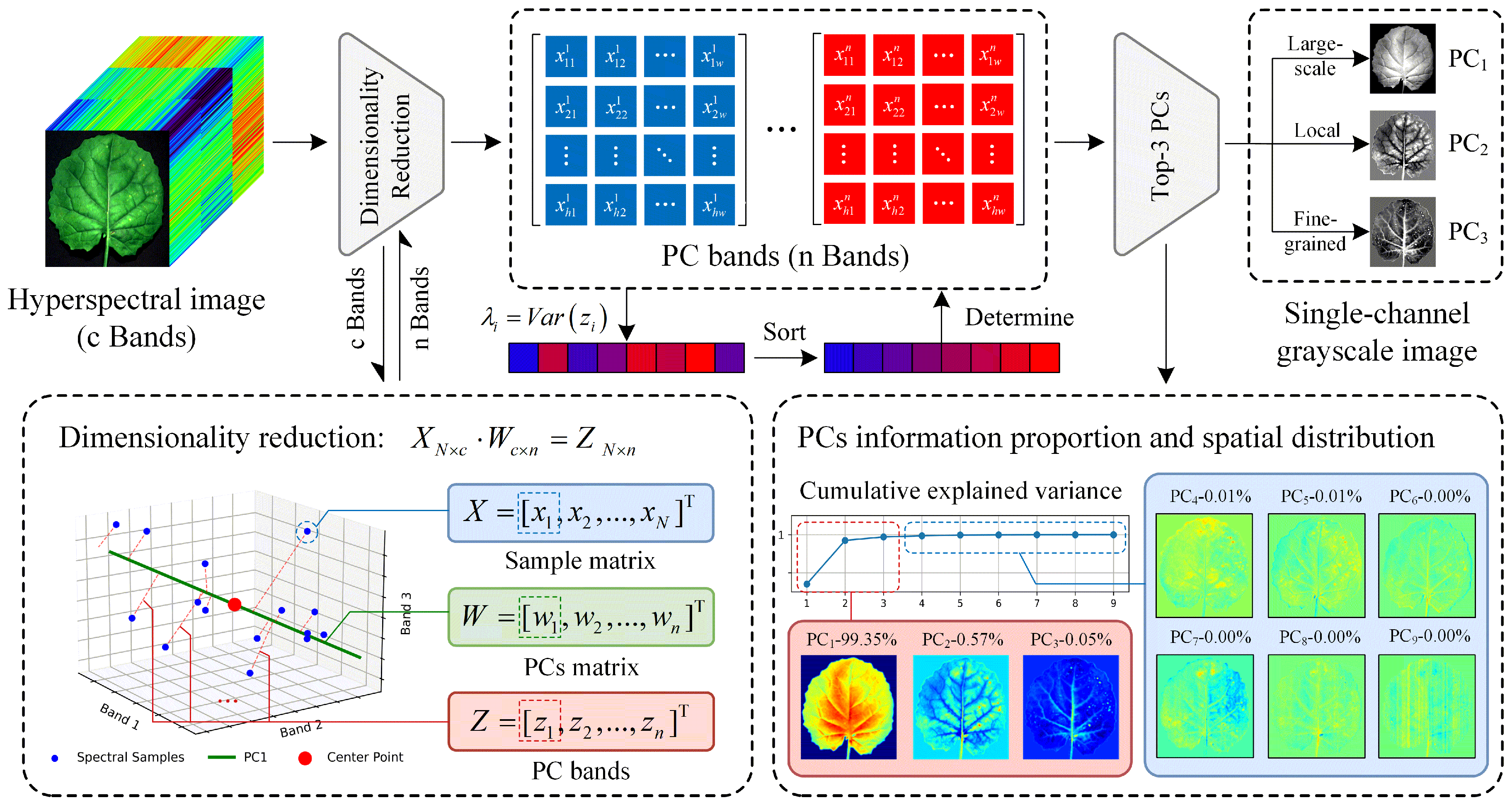
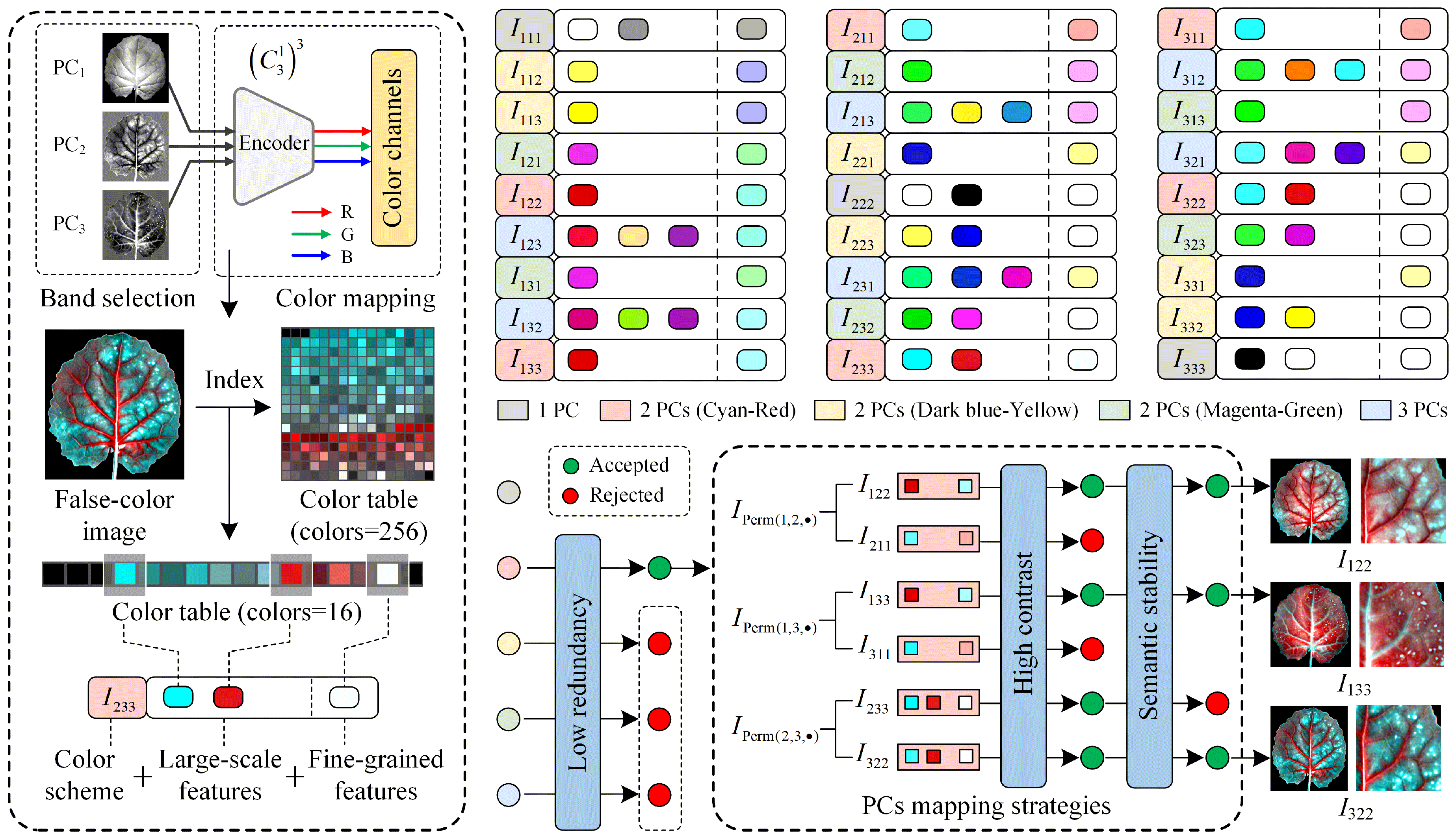
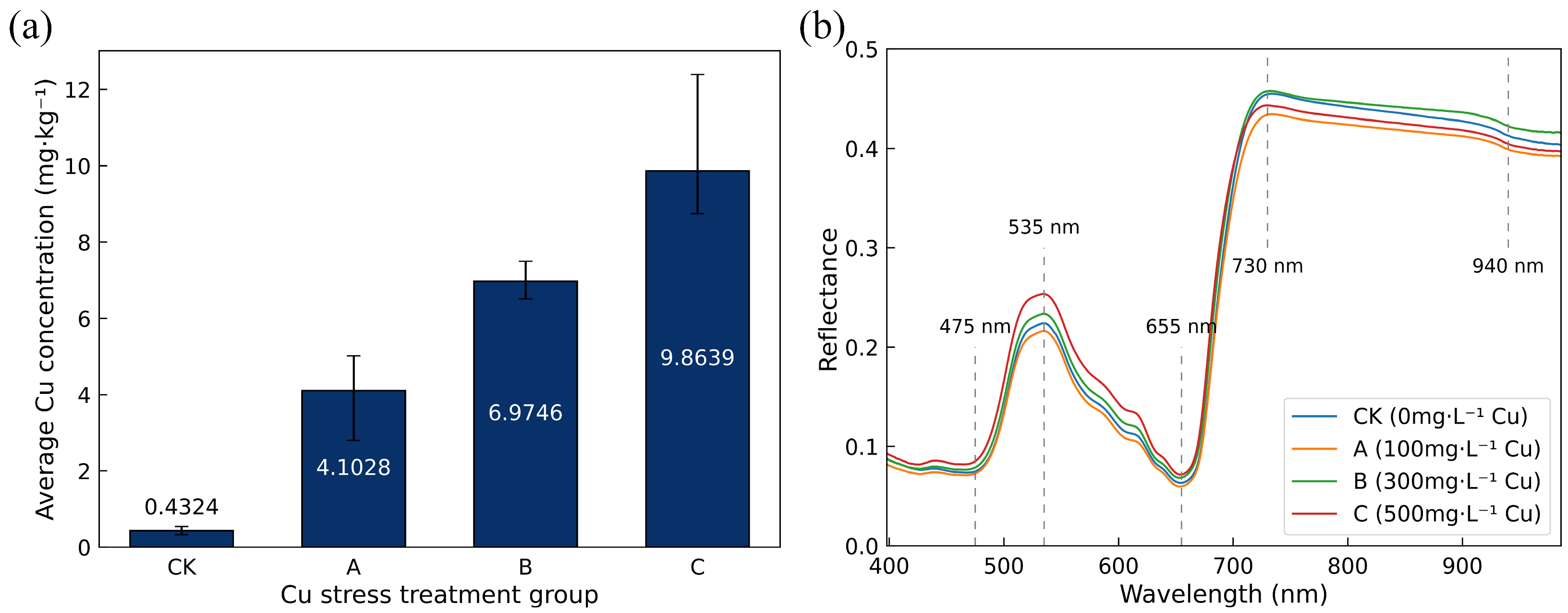
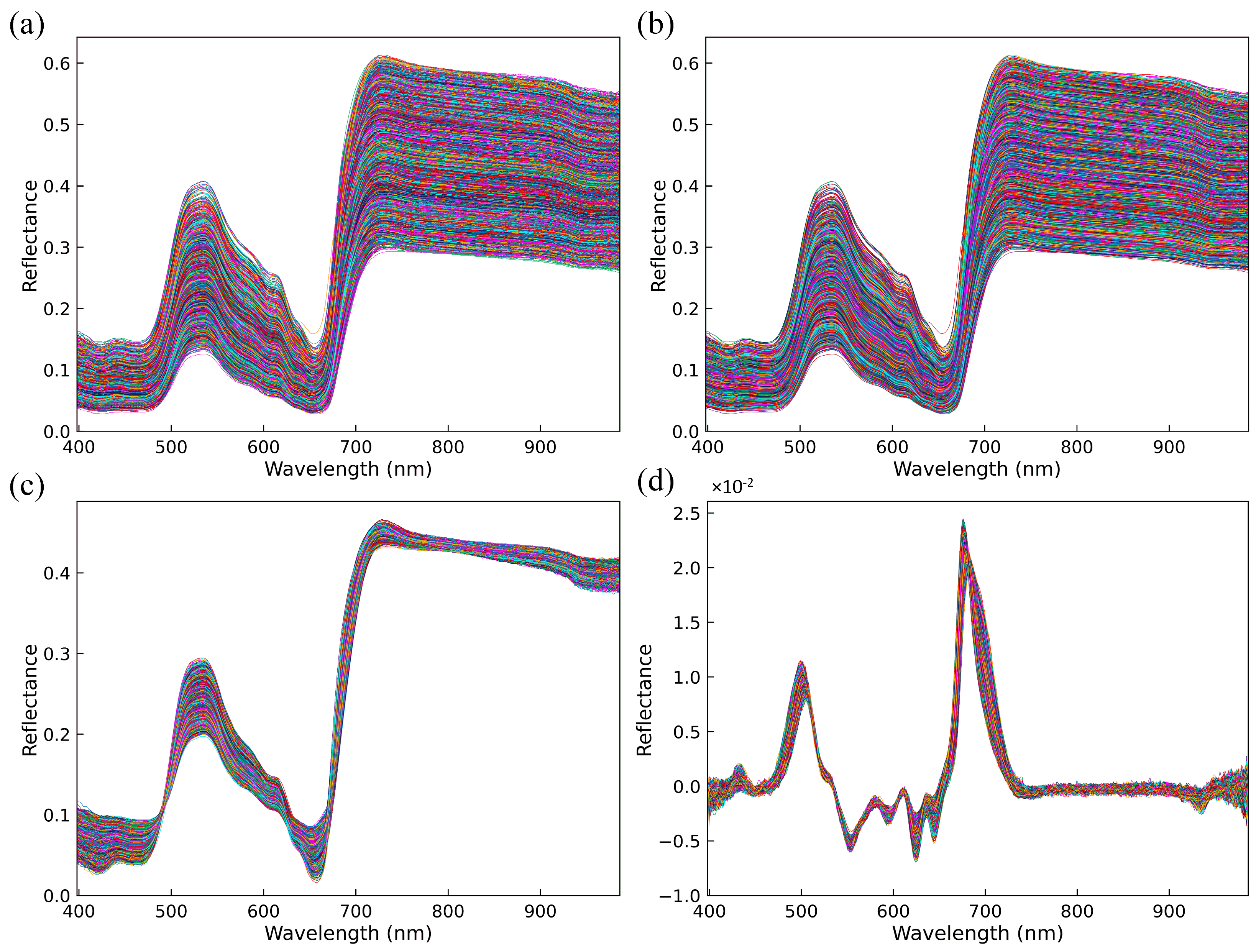
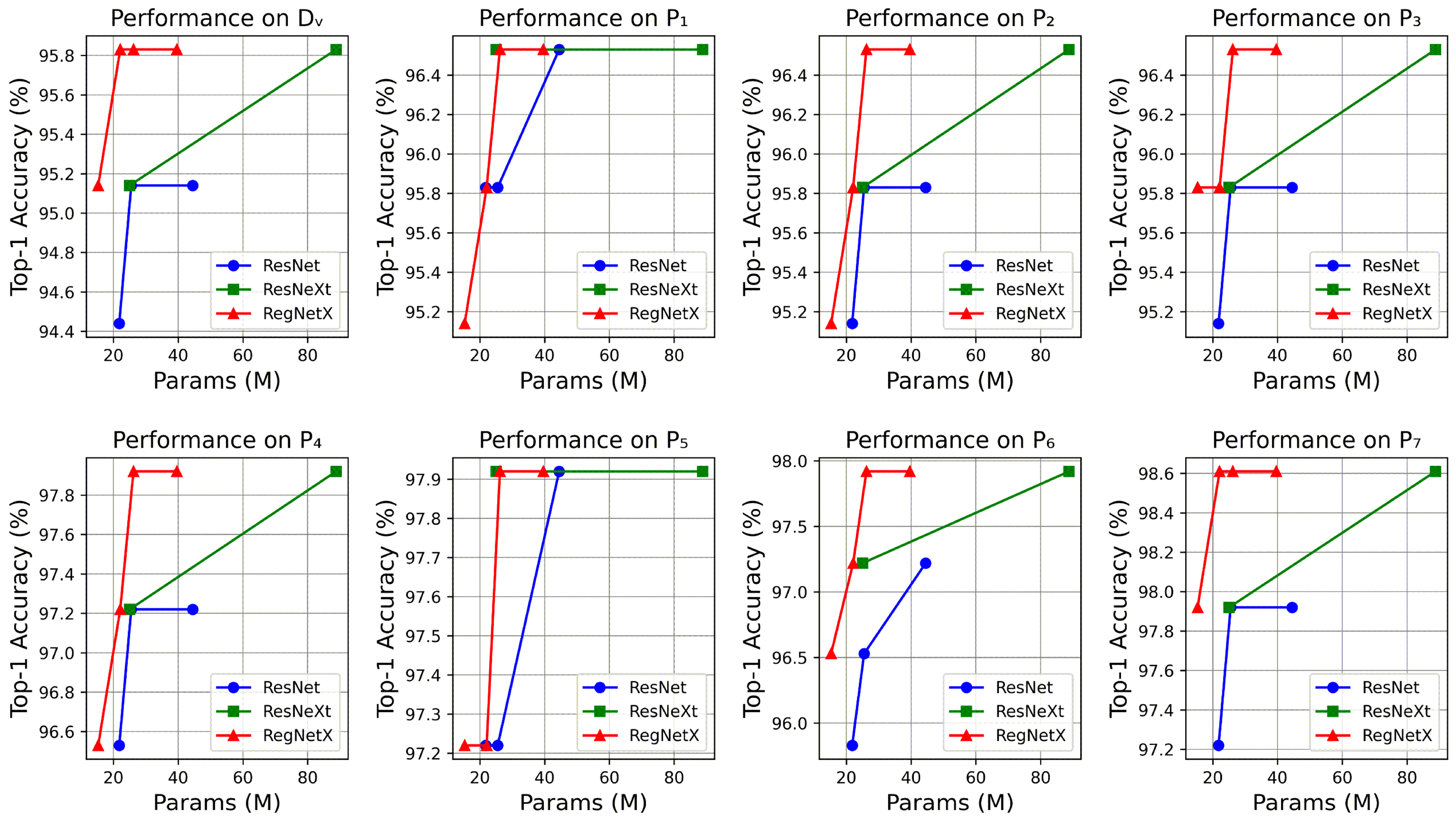


| Preprocessing Method | Macro-Precision (%) | Macro-Recall (%) | Macro-F1 (%) | Accuracy (%) | ||||
|---|---|---|---|---|---|---|---|---|
| SVM | B1DCNN | SVM | B1DCNN | SVM | B1DCNN | SVM | B1DCNN | |
| Raw | 93.27 | 92.99 | 93.36 | 93.07 | 93.28 | 93.02 | 93.37 | 93.14 |
| SG | 92.13 | 94.20 | 92.17 | 94.21 | 92.10 | 94.20 | 92.19 | 94.32 |
| MSC | 93.13 | 94.43 | 93.29 | 94.34 | 93.20 | 94.38 | 93.25 | 94.44 |
| SG-GD-MSC | 93.35 | 95.22 | 93.49 | 95.08 | 93.41 | 95.13 | 93.49 | 95.15 |
| 1D Model | Preprocessing | Macro-Precision (%) | Macro-Recall (%) | Macro-F1 (%) | Accuracy (%) |
|---|---|---|---|---|---|
| ResNet-50 | Raw | 95.50 | 95.49 | 95.49 | 95.51 |
| SG | 95.70 | 95.68 | 95.65 | 95.63 | |
| MSC | 95.76 | 95.86 | 95.78 | 95.74 | |
| SG-GD-MSC | 96.13 | 96.12 | 96.12 | 96.10 | |
| ResNeXt-50 (32 × 4d) | Raw | 95.91 | 96.00 | 95.93 | 95.98 |
| SG | 96.14 | 96.10 | 96.10 | 96.10 | |
| MSC | 96.12 | 96.18 | 96.14 | 96.22 | |
| SG-GD-MSC | 96.36 | 96.33 | 96.34 | 96.34 | |
| RegNetX-6.4GF | Raw | 96.45 | 96.51 | 96.47 | 96.45 |
| SG | 96.59 | 96.64 | 96.60 | 96.57 | |
| MSC | 96.47 | 96.53 | 96.49 | 96.57 | |
| SG-GD-MSC | 96.69 | 96.73 | 96.70 | 96.69 |
| Model | Macro-Precision (%) | Macro-Recall (%) | Macro-F1 (%) | Accuracy (%) |
|---|---|---|---|---|
| ResNet-50 | 96.83 | 96.76 | 96.77 | 96.76 |
| ResNeXt-50 (32 × 4d) | 97.26 | 97.22 | 97.23 | 97.22 |
| RegNetX-6.4GF | 98.17 | 98.15 | 98.15 | 98.15 |
Disclaimer/Publisher’s Note: The statements, opinions and data contained in all publications are solely those of the individual author(s) and contributor(s) and not of MDPI and/or the editor(s). MDPI and/or the editor(s) disclaim responsibility for any injury to people or property resulting from any ideas, methods, instructions or products referred to in the content. |
© 2025 by the authors. Licensee MDPI, Basel, Switzerland. This article is an open access article distributed under the terms and conditions of the Creative Commons Attribution (CC BY) license (https://creativecommons.org/licenses/by/4.0/).
Share and Cite
Peng, Y.; Sun, J.; Cai, Z.; Shi, L.; Wu, X.; Dai, C.; Xie, Y. Copper Stress Levels Classification in Oilseed Rape Using Deep Residual Networks and Hyperspectral False-Color Images. Horticulturae 2025, 11, 840. https://doi.org/10.3390/horticulturae11070840
Peng Y, Sun J, Cai Z, Shi L, Wu X, Dai C, Xie Y. Copper Stress Levels Classification in Oilseed Rape Using Deep Residual Networks and Hyperspectral False-Color Images. Horticulturae. 2025; 11(7):840. https://doi.org/10.3390/horticulturae11070840
Chicago/Turabian StylePeng, Yifei, Jun Sun, Zhentao Cai, Lei Shi, Xiaohong Wu, Chunxia Dai, and Yubin Xie. 2025. "Copper Stress Levels Classification in Oilseed Rape Using Deep Residual Networks and Hyperspectral False-Color Images" Horticulturae 11, no. 7: 840. https://doi.org/10.3390/horticulturae11070840
APA StylePeng, Y., Sun, J., Cai, Z., Shi, L., Wu, X., Dai, C., & Xie, Y. (2025). Copper Stress Levels Classification in Oilseed Rape Using Deep Residual Networks and Hyperspectral False-Color Images. Horticulturae, 11(7), 840. https://doi.org/10.3390/horticulturae11070840







